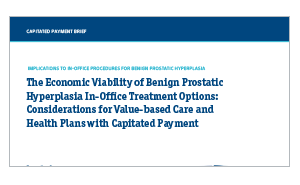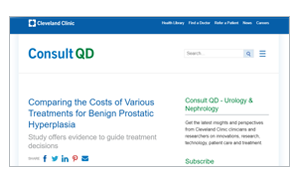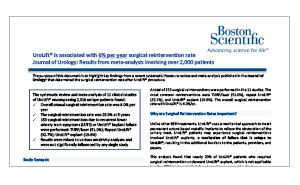PHYSICIAN'S PERSPECTIVES
The Importance of Cost Efficiency in BPH Treatment
Be the First To Know.
Editorial Commentary
Justin Cohen, MD
Executive Vice President and Chief Compliance Officer, UroPartners LCC, Libertyville, IL
Board Chairman of Advocate Physician Partners, Downers Grove, IL
Although clinical efficacy is my top consideration when recommending a treatment to my patients, other goals such as side effect profile, complication risk and cost-effectiveness are also critically important to me.
Given rising concerns about the expense of healthcare, physicians must be good stewards of the healthcare dollar, or we risk intervention wherein governmental agencies or insurance providers intervene further in choices which are best left to the intimate discussions between physicians and patients.
As a urologist and Chairman of the Board of Directors of an integrated Accountable Care Organization (wherein we are accountable for both the quality and cost-effectiveness of our care) linking nearly 5,000 providers with a large hospital system, I am frequently tasked with ensuring that treatment recommendations attempt to achieve four goals – the so-called “Quadruple Aim” of healthcare. The ideal of the Quadruple Aim is to enhance patient experience, improve population health, reduce costs, and improve the work life of healthcare providers.
BPH Treatment Approaches
One area in my practice where I feel it is frequently possible to achieve excellent outcomes while limiting risks and expense to patients is the treatment of patients with lower urinary tract symptoms (LUTS) associated with benign prostatic hyperplasia (BPH). This is an increasingly pervasive condition significantly affecting the quality of life among our aging population. Given the number of patients treated for BPH each year, finding a highly effective and durable treatment which is also cost-effective is critical.1-5
Treatment options for LUTS associated with BPH include behavioral modifications, pharmaceuticals and a number of surgical interventions ranging from minimally invasive to maximally invasive surgery.6 So, how do I choose?
Safety and Efficacy of the Overall Treatment Options
First, I assess the overall safety and efficacy of each option and how it applies to my particular patient’s symptoms.
Drug therapy is most often the first-line treatment for BPH with LUTS. Although alpha blockers and 5-alpha reductase inhibitors are generally safe and effective, they also have some common side effects, such as dizziness, orthostasis, intraoperative floppy iris syndrome, retrograde ejaculation, decreased energy, erectile dysfunction (ED) and decreased libido.7,8 As a result of these side effects, it is not uncommon for patients to be non-compliant with or discontinue the medication regimen.7 Furthermore, patients are frequently prescribed medications for years, which may allow the prostate to become very large (if on alpha blockers)9 while potentially developing permanent bladder changes,10 possibly making future intervention more difficult and less successful. Steve Kaplan, MD, has provided a great outline on the Effect of Delayed BPH Procedural Intervention.
In my opinion, while Photoselective Vaporization of the Prostate (PVP) and Transurethral Resection of the Prostate (TURP) are effective, they can carry a high rate of sexual dysfunction in addition to risks associated with general anesthesia.11,12
In my experience, Holmium Laser Enucleation of the Prostate (HoLEP) and Prostatic Arterial Embolization (PAE) have a steep learning curve. Simple prostatectomy, whether robotic or open, is highly effective but comes with the drawbacks common to major surgery, including long hours in the operating room, hospitalization, bleeding and other complications.13
New Minimally Invasive Therapy (MIT) procedures can be effective options that have become increasingly more common. The two most prominent MITs for patients with LUTS currently are UroLift™ Prostatic Urethral Lift System, which places permanent implants to hold open the lateral lobes of the prostate to reduce urinary obstruction, and Rezūm™ Water Vapor Therapy, which uses convective thermal energy transfer (steam injections) to ablate prostatic tissue.14,15
How MITs Stack Up Against Alternatives
In my experience, the safety, efficacy and durability of MITs in properly selected patients hold up well against the alternatives:*
- Efficacy – Both Rezūm Therapy and UroLift have been shown to provide significant, sustained relief of lower urinary tract symptoms and improved quality of life for patients with BPH five years after the procedure.12,16
- Durability – Through five years, the surgical retreatment rate with Rezūm Therapy was 4.4 percent, compared to 13.6 percent for UroLift.*,14,15 Rezūm Therapy has lower rates of BPH clinical progression than daily dose medications.*,17
- Side Effects – Both Rezūm Therapy and UroLift do not have the sexual side effect profile common to BPH medications and more invasive BPH procedures performed by urologists. In fact, in the Rezūm Therapy pivotal study, there were no reports of de novo device or procedure-related ED throughout the duration of the study.14 And in the UroLift pivotal study, there were no new cases of ED or ejaculatory dysfunction.15 The American Urological Association acknowledges both Rezūm Therapy and UroLift’s ability to preserve sexual function.6 Some of the potential side effects common to both Rezūm Therapy and UroLift include but are not limited to dysuria, hematuria, urinary frequency, retention, and urgency.
The patient experience is also important when comparing interventional treatment options. Rezūm Therapy can be done in less than an hour, in-office, and without general anesthesia or an overnight hospital stay.14 Rezūm Therapy is also associated with a lower overall retreatment rate than UroLift.*,14,15 My colleagues wrote an interesting paper about top considerations for evaluating MITs.
Financial Considerations of BPH Therapies
After looking at the safety and efficacy of the various alternatives, I then assess how cost effective the options are for patients and for the health system. Here are some of the questions that drive my inquiry:
What will the alternative treatments cost the patient?
This is a crucial question for patients, especially those with high co-pays or high-deductible plans.18 For example, Medicare patients, who pay 20 percent of the costs, pay an average of $360 for a Rezūm Therapy procedure in the office site of service compared to $1,239 for a UroLift procedure, according to an analysis.18 Additionally, Boston Scientific offers a Patient Assurance program for Rezūm Therapy so that out-of-pocket costs are limited if a patient should need a second BPH procedure following their initial Rezūm Therapy procedure.
How will the treatment affect my practice?
This includes looking at the in-office economics of the treatments, including how many procedures can be safely done in a day. Clearly, MITs have an advantage over surgery at a hospital or Ambulatory Surgery Center (ASC) because they can be successfully performed in a fraction of the time.18 That is not only good for my practice, but it is also a benefit for patients and for the overall healthcare system.
When it comes to in-office economics, Rezūm Therapy has one major advantage over UroLift – lower inventory costs. In my experience, UroLift requires surgeons to hold surplus UroLift clips in inventory – you never know exactly how many you will need for any given procedure – and that can be a significant upfront overhead expense burden for practices. In my experience, Rezūm Therapy, on the other hand, offers a fixed-cost approach per patient.
What is the impact on the overall health care system?
Research shows that Rezūm Therapy is typically the most cost-effective option for the treatment of BPH.19 The Rezūm Therapy surgical retreatment rate (according to the Rezūm II study) is 4.4% whereas the UroLift surgical retreatment rate (according to the LIFT study) is 13.6%.14,15 In addition, Rezūm Therapy costs considerably less than UroLift per surgical intervention and overall.20 Also, given the impending shortage of urologists, the ability to treat patients in the office rather than in a hospital or surgical center operating room creates efficiencies wherein we can care for more patients per day, which is a benefit to the overall healthcare system.21
Cost Analysis from Cleveland Clinic22
A recent study at Cleveland Clinic analyzed surgical costs, based on 2017 Medicare reimbursement for common BPH treatments and found the following:
- Office-based procedures achieved cost equivalence with combination medical therapy in less than two years, with Rezūm Therapy outperforming the UroLift by over six months.
- Outpatient surgery reached cost equivalence with combination medical therapy within the first two years and did so sooner than UroLift.
- Inpatient treatments were generally most expensive and achieved cost equivalence with combination medical therapy between 1.74 and 4.12 years.
Achieving the Quadruple Aim
As healthcare providers, we must find a way to provide the highest quality of service to patients without sacrificing quality. We must find treatments that offer patients a minimally invasive and safe experience, save them money and reduce stress on healthcare practices and the overall system through efficient use of limited time and resources.
Achieving this Quadruple Aim is key to the future of healthcare. In my experience, Rezūm Therapy is one of the treatments that is ushering us into that future.
* Results from different clinical investigations are not directly comparable. Information provided for educational purposes only.
Related Content

Economic viability of BPH in-office treatment options

BPH treatment cost analysis from Cleveland Clinic

Meta-analysis confirms 28.9% surgical reintervention rate with UroLift at 5 years
Download a copy of this summary
Indications, safety and warnings
